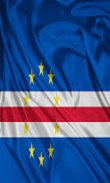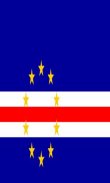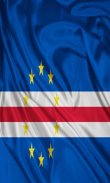







Cape Verde Flag

Описание Cape Verde Flag
The national flag of Cape Verde was adopted on September 22, 1992, replacing the flag adopted during Cape Verdean independence, fought for with Guinea-Bissau, another former Portuguese colony on mainland West Africa.
The 10 stars on the flag represent the main islands of the nation (a chain of islands off the coast of West Africa). The blue represents the ocean and the sky. The band of white and red represents the road toward the construction of the nation, and the colours stand for peace (white) and effort (red). The yellow colour, circular formation of the stars, and dark blue field show similarity to the flag of Europe with 12 stars instead of 10, originally designed for the Council of Europe, but also used by the European Union. The stripes are in 6:1:1:1:3 ratio, and the circle of stars is centred 3/8 along the fly.
Despite its remoteness in elevation with all but 3 islands being mountainous, the lack of natural resources, its isolation from many other countries, and devastating famines in the later 20th century, Cape Verde has won a positive reputation in promoting what is considered the most stable democracy in Africa, a standard of living higher than most African nations, and one of the most politically liberal nations on the continent, and in the world.
Cape Verde (pop. 506,000) is located 500 km from the west coast of Africa. The once uninhabited islands were discovered and colonized by the Portuguese in the 15th century; they subsequently became a trading center for African slaves and later an important coaling and re-supply stop for whaling and transatlantic shipping. Independence was achieved in 1975.
Национальный флаг Кабо-Верде была принята 22 сентября 1992 года, заменив флаг, принятый во Кабо-Верде независимости, боролись за с Гвинеей-Бисау, другой бывшей португальской колонии на материковой части Западной Африки.
В 10 звезд на флаге представляют основные островов нации (цепь островов у побережья Западной Африки). Синий представляет океан и небо. Группа белых и красных представляет дорогу к строительству нации, и цвета за мир (белый) и усилий (красный). Желтый цвет, кольцевое образование из звезд, и темно-синее поле показать сходство с флагом Европы с 12 звездами, а не 10, первоначально предназначенных для Совета Европы, но также используются в Европейском Союзе. Полосы в 6: 1: 1: 1: 3, и круг звезд сосредоточена 3/8 по ходу.
Несмотря на удаленность в высоте с все, но 3 острова будучи горный, отсутствие природных ресурсов, его изоляция от многих других стран, и разрушительные голод в позднем 20-го века, Кабо-Верде выиграл положительную репутацию в продвижении того, что считается самым стабильным демократия в Африке, жизненный выше, чем большинство африканских стран, и один из самых политически либеральной наций континента, и в мире.
Кабо-Верде (поп. 506000) находится в 500 км от западного побережья Африки. Когда-то необитаемые острова были обнаружены и колонизирована португальцами в 15 веке; они впоследствии стал торговым центром для африканских рабов, а позже важным угольная и повторно питания остановка китобойного промысла и трансатлантического судоходства. Независимость была достигнута в 1975 году.

























